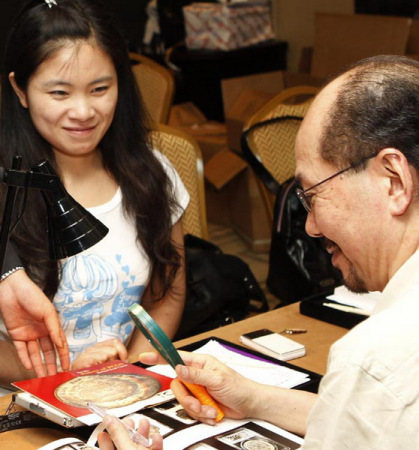
Chinese investors are showing an increasing interest in stamps and coins in recent years. (Photo/Xinhua)
Antique coins, vintage cars among other favorites, says report
Faced with the economic downturn, the devaluation of the renminbi and dwindling personal wealth, Chinese investors are seeking new outlets to diversify their investment.
They are showing an increasing interest in stamps and coins in recent years, and account for one-third of the $3 billion global philately market, according to the latest Alternative Investment Report from the London-based investment service provider Intelligent Partnership.
The report, sponsored by well-known stamp and coin dealer Stanley Gibbons, shows that out of the 60 million collectors from all over the world, 20 million are based in China.
These Chinese wealthy individuals hold an average of 18 percent of their total net worth in "treasure assets" such as rare stamps, coins, paintings and vintage cars.
"Stamps and coins present investors with one way to beat the financial repression of the low interest rates, money printing and the silent currency war that central banks are resorting to in order to stimulate the economy. They can be a hedge against-and protection from-inflation, devalued currencies and punitive taxes," said Guy Tolhurst, managing director of Intelligent Partnership.
Investments of passion, which refer to anything that is tangible and not a conventional financial instrument, have performed strongly over the past 10 years compared with traditional investments such as shares. Intelligent Partnership experts attribute the growing popularity of stamps in China to their growing value.
The report said that over the past decade the annual growth rate of investments in stamps was 11.43 percent, outperforming China's 2014 GDP growth rate of 7.4 percent.
What's more, a record was set last year for a public stamp sale when an 1856 British Guiana 1 cent magenta sold for 5.6 million pounds ($8.3 million) at an auction.
According to the China National Philatelic Corporation, the second half of 2014 witnessed an instant boost in the philately market. Chronicle sheets of stamps had unprecedentedly good sales which had not been seen in 10 years.
China's growing middle class is also boosting the viability of stamps as an investment, the Intelligent Partnership experts said. According to market consultancy company McKinsey & Company, around 76 percent of Chinese households will reach the middle-income level in 2022, while the figure was only 4 percent in 2000.
By 2022, the annual disposable income of each of these families will be between 60,000 yuan ($9,773) and 229,000 yuan, which is equal to the level in Brazil and Italy. Products or services which stress emotional and social aspects will gain more preference.
Chinese investors have made their investment portfolio quite diverse in recent years. Apart from investment in overseas companies and the financial market, investment in art works has become one of the major alternative investments of the Chinese billionaires who have an average personal wealth of 1.82 billion yuan, according to the China Ultra High Net Wealth Report 2014-2015, jointly released by Hurun Report and China Minsheng Bank on Thursday.
Jade and jewelry are the most popular investment items in terms of art works, with 45 percent of the 17,000 shortlisted billionaires investing in this category. Chinese traditional calligraphy and paintings were the second-most popular category while modern art works came in the third. Antiques came next to the above three major categories, with 24 percent of the billionaires investing in them.
















































